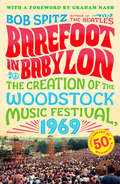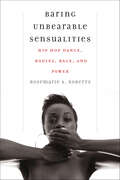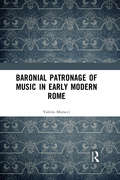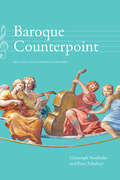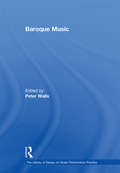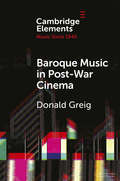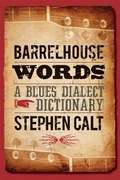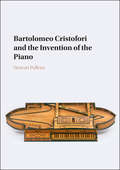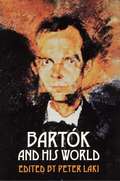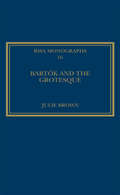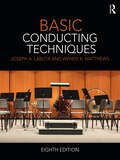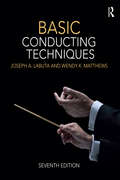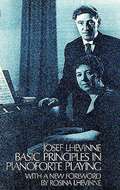- Table View
- List View
Barefoot in Babylon: The Creation of the Woodstock Music Festival, 1969
by Bob Spitz"Mr. Spitz feeds us every riveting detail of the chaos that underscored the festival. It makes for some out-a-sight reading, man." The New York Times Book Review Celebrating its 45th anniversary in 2014, the Woodstock Music Festival defined a generation. Yet, there was much more than peace and love driving that long weekend the summer of 1969. In Barefoot in Babylon, journalist and New York Times bestselling author Bob Spitz gives readers a behind-the-scenes look at the making of Woodstock, from its inception and the incredible musicians that performed to its scandals and the darker side of the peace movement. With a new introduction, as well as maps, set lists, and a breakdown of all the personalities involved, Barefoot in Babylon is a must-read for anyone who was there--or wishes they were.
Barenaked Ladies: Public Stunts, Private Stories
by Paul MyersWant to know more about this Canadian quintet? It's all here, from the births of five Barenaked babies to the triumph of band member Kevin over leukemia.
Baring Unbearable Sensualities: Hip Hop Dance, Bodies, Race, and Power
by Rosemarie A. RobertsShort Listed for the 2022 de la Torre Bueno© First Book AwardShort Listed for the 2022 Oscar G. Brockett Book Prize for Dance ResearchBaring Unbearable Sensualities brings together a bold methodology, an interdisciplinary perspective and a rich array of primary sources to deepen and complicate mainstream understandings of Hip Hop dance, an Afro-diasporic dance form, which have generally reduced the style to a set of techniques divorced from social contexts. Drawing on close observation and interviews with Hip Hop pioneers and their students, Rosemarie A. Roberts proposes that Hip Hop dance is a collective and sentient process of resisting oppressive manifestations of race and power. Roberts argues that the experiences of marginalized Black and Brown bodies materialize in and through Hip Hop dance from the streets of urban centers to contemporary worldwide expressions. A companion web site contains over 30 video clips referenced in the text.Publication of this book is funded by the Beatrice Fox Auerbach Foundation Fund at the Hartford Foundation for Public Giving.
Barn Dances and Jamborees Across Kentucky (Music Ser.)
by J. D. WilkesKentuckians have been wearing out shoe leather at informal jamborees since the state was settled over two hundred years ago. Tadpole's Dew Drop Inn played host to some fifteen hundred musical shindigs in its time as a mecca of Marshall County music. A Rosine barn dance gave bluegrass founder Bill Monroe his start, and another fosters new musical talent at its weekly get-togethers. Clawhammer banjo players, Appalachian cloggers and square dance callers from Possum Trot to Rabbit Hash celebrate the unique musical culture of Kentucky. Join Grammy-nominated soundtrack artist J.D. Wilkes as he waltzes around the Bluegrass, looking for oprys, socials, porch pickins and barn dances in every holler.
Baronial Patronage of Music in Early Modern Rome
by Valerio MorucciThis is the first dedicated study of the musical patronage of Roman baronial families in the sixteenth and early seventeenth centuries. Patronage – the support of a person or institution and their work by a patron – in Renaissance society was the basis of a complex network of familial and political relationships between clients and patrons, whose ideas, values, and norms of behavior were shared with the collective. Bringing to light new archival documentation, this book examines the intricate network of patronage interrelationships in Rome. Unlike other Italian cities where political control was monocentric and exercised by single rulers, sources of patronage in Rome comprised a multiplicity of courts and potential patrons, which included the pope, high prelates, nobles and foreign diplomats. Morucci uses archival records, and the correspondence of the Orsini and Colonna families in particular, to investigate the local activity and circulation of musicians and the cultivation of music within the broader civic network of Roman aristocratic families over the period. The author also shows that the familial union of the Medici and Orsini families established a bidirectional network for artistic exchange outside of the Eternal City, and that the Orsini-Colonna circle represented a musical bridge between Naples, Rome, and Florence.
Baroque Counterpoint: Revised and Expanded Edition
by Peter Schubert Christoph NeidhoferThe classic text on Baroque Counterpoint, enlarged and revised, drawing from the master composers of the era.This book teaches Baroque compositional techniques through writing and improvisation exercises and analysis of repertoire examples. It provides readers with a historical outlook by focusing largely on principles taught in treatises from the period 1680–1780. This expanded edition includes new sections with keyboard exercises that provide training in Partimento performance as it was practiced at the time, helping students master Baroque style from the inside. While the focus of the book is on fugue, it also treats chorale preludes, stylized dances, inventions, and trio sonatas. The volume is divided into two parts-basic and advanced- which could be taught in a two-semester sequence. There are various options to introduce material from Part II into Part I for a one-semester course.
Baroque Music (The\library Of Essays On Music Performance Practice Ser. #3)
by Peter WallsResearch in the 20th and 21st centuries into historical performance practice has changed not just the way performers approach music of the 17th and 18th centuries but, eventually, the way audiences listen to it. This volume, beginning with a 1915 Saint-Sa lecture on the performance of old music, sets out to capture musicological discussion that has actually changed the way Baroque music can sound. The articles deal with historical instruments, pitch, tuning, temperament, the nexus between technique and style, vibrato, the performance implications of musical scores, and some of the vexed questions relating to rhythmic alteration. It closes with a section on the musicological challenges to the ideology of the early music movement mounted (principally) in the 1990s. Leading writers on historical performance practice are represented. Recognizing that significant developments in historically-inspired performance have been led by instrument makers and performers, the volume also contains representative essays by key practitioners.
Baroque Music in Post-War Cinema: Performance Practice and Musical Style (Elements in Music since 1945)
by Donald GreigStudies of pre-existing music in narrative cinema often focus on a single film, composer or director. The approach here adopts a wider perspective, placing a specific musical repertoire - baroque music - in the context of its reception to explore its mobilisation in post-war cinema. It shows how various revivals have shaped musical fashion, and how cinema has drawn on resultant popularity and in turn contributed to it. Close analyses of various films raise issues of baroque musical style and form to question why eighteenth-century music remains an exception to dominant film-music discourses. Account is taken of changing modern performance practice and its manifestation in cinema, particularly in the biopic. This question of the reimagining of baroque repertoire leads to consideration of pastiches and parodies to which cinema has been particularly drawn, and subsequently to the role that neobaroque music has played in more recent films.
Baroque Piety: Religion, Society, and Music in Leipzig, 1650-1750
by Tanya KevorkianDrawing upon a rich array of sources from archives in Leipzig, Dresden and Halle, Tanya Kevorkian illuminates culture in Leipzig before and during J.S. Bach's time in the city. Working with these sources, she has been able to reconstruct the contexts of Baroque and Pietist cultures at key periods in their development much more specifically than has been done previously. Kevorkian shows that high Baroque culture emerged through a combination of traditional frameworks and practices, and an infusion of change that set in after 1680. Among other forms of change, new secular arenas appeared, influencing church music and provoking reactions from Pietists, who developed alternative meeting, networking and liturgical styles. The book focuses on the everyday practices and active roles of audiences in public religious life. It examines music performance and reception from the perspectives of both 'ordinary' people and elites. Church services are studied in detail, providing a broad sense of how people behaved and listened to the music. Kevorkian also reconstructs the world of patronage and power of city councillors and clerics as they interacted with other Leipzig inhabitants, thereby illuminating the working environment of J.S. Bach, Telemann and other musicians. In addition, Kevorkian reconstructs the social history of Pietists in Leipzig from 1688 to the 1730s.
Baroque Woodwind Instruments: A Guide to Their History, Repertoire and Basic Technique
by Paul CarrollThe late 17th century through to the end of the 18th century saw rapid progress in the development of woodwind instruments and the composition of a vast body of music for those instruments. During this period a large amount of music for domestic consumption was written for a growing amateur market, a market which has regrown in the latter part of the 20th century. The last 30 years has also seen the standard of performance by professionals on these instruments rise enormously. This book provides a guide to the history of the four main woodwind instruments of the Baroque, the flute, oboe, recorder and bassoon, and this is complemented by a repertoire list for each instrument. It also guides those interested towards a basic technique for playing these instruments - a certain level of musical literacy is assumed - and it can be used by students, professionals and amateurs. Advice is also given on buying a suitable reproduction instrument from a market where now virtually any Baroque instrument can be obtained as a faithful copy. This is the first book of its kind and has its origins in the wind tutors of the 18th century.
Barred for Life: How Black Flag's Iconic Logo Became Punk Rock's Secret Handshake
by Stewart Dean EbersoleCataloging the legacy of the American punk rock pioneers Black Flag, this photo documentary uses stark, contrasting portraits to share the stories of the die-hard fans who wear the iconic four-barred logo tattooed on their skin. From doctors to homeless punks, stories range from the intensely personal to the absurd as each larger-than-life soul mugs for the camera. Adding to the idea that mixed messages can come from one unifying design, each image is highlighted with a personal quotation, a name and bio, and a Black Flag favorites list. Captured during an extensive tour through the United States, Canada, and Western Europe, this collection serves as a visual testimony to the hyper-distilled mythology that the band is more prevalent now than when it was in service, and serves as a soundtrack for those living as self-imposed cultural outsiders. Interviews with former members of the band, tattoo artists, photographers, and other relevant luminaries round out this ethnography and serve to spotlight Black Flag's vicious live performances, forward-thinking work ethic, and indisputable reputation for acting as both champions and destroyers of the punk rock culture that they helped create.
Barrelhouse Blues: Location Recording and the Early Traditions of the Blues
by Paul OliverIn the 1920s, Southern record companies ventured to cities like Dallas, Atlanta, and New Orleans, where they set up primitive recording equipment in makeshift studios. They brought in street singers, medicine show performers, pianists from the juke joints and barrelhouses. The music that circulated through Southern work camps, prison farms, and vaudeville shows would be lost to us if it hadn't been captured on location by these performers and recorders.Eminent blues historian Paul Oliver uncovers these folk traditions and the circumstances under which they were recorded, rescuing the forefathers of the blues who were lost before they even had a chance to be heard. A careful excavation of the earliest recordings of the blues by one of its foremost experts, Barrelhouse Blues expands our definition of that most American style of music.
Barrelhouse Words: A Blues Dialect Dictionary
by Stephen CaltThis fascinating compendium explains the most unusual, obscure, and curious words and expressions from vintage blues music. Utilizing both documentary evidence and invaluable interviews with a number of now-deceased musicians from the 1920s and '30s, blues scholar Stephen Calt unravels the nuances of more than twelve hundred idioms and proper or place names found on oft-overlooked "race records" recorded between 1923 and 1949. From "aggravatin' papa" to "yas-yas-yas" and everything in between, this truly unique, racy, and compelling resource decodes a neglected speech for general readers and researchers alike, offering invaluable information about black language and American slang.
Barrie Kosky on the Contemporary Australian Stage: Affect, Post-Tragedy, Emergency (Routledge Advances in Theatre & Performance Studies)
by Charlotte FarrellThis is the first book-length study of Australian theatre productions by internationally-renowned director, Barrie Kosky. Now a prolific opera director in Europe, Barrie Kosky on the Contemporary Australian Stage accounts for the formative years of Kosky's career in Australia. This book provides in-depth engagements with select productions including The Dybbuk which Kosky directed with Gilgul theatre company in 1991, as well as King Lear (1998), The Lost Echo (2006), and Women of Troy (2008). Using affect theory as a prism through which these works are analysed, the book accounts for the director's particular engagement with – and radical departure from – classical tragedy in contemporary performance: what the book defines as Kosky's 'post-tragedies'. Theatre studies scholars and students, particularly those with interests in affect, contemporary performance, 'director's theatre', and tragedy, will benefit from Barrie Kosky on the Contemporary Australian Stage’s vivid engagement with Kosky's work: a director who has become a singular figure in opera and theatre of international critical acclaim.
Barron's AP Music Theory
by Nancy ScogginThis brand-new addition to Barron's series of Advanced Placement test prep manuals presents a comprehensive review of music theory, followed by two full-length practice tests with all questions answered and explained. These practice tests include both aural and non-aural sections. The four audio CDs enclosed with the manual provide aural skill development prompts for both practice tests' aural sections, as well as material that complements exercises and examples in the subject review chapters. Topics covered in the review chapters include music fundamentals, harmonic organization, harmonic progression, melodic composition and dictation, relationship of key centers, harmonic dictation and composition, visual score analysis, contextual listening, strategies for harmonizing and sight-singing, and much more. Multiple-choice questions with strategies for test-taking success appear at the end of many chapters.
Bars, Blues, and Booze: Stories from the Drink House (American Made Music Series)
by Emily D. EdwardsBars, Blues, and Booze collects lively bar tales from the intersection of black and white musical cultures in the South. Many of these stories do not seem dignified, decent, or filled with uplifting euphoria, but they are real narratives of people who worked hard with their hands during the week to celebrate the weekend with music and mind-altering substances. These are stories of musicians who may not be famous celebrities but are men and women deeply occupied with their craft--professional musicians stuck with a day job. The collection also includes stories from fans and bar owners, people vital to shaping a local music scene. The stories explore the "crossroads," that intoxicated intersection of spirituality, race, and music that forms a rich, southern vernacular. In personal narratives, musicians and partygoers relate tales of narrow escape (almost getting busted by the law while transporting moonshine), of desperate poverty (rat-infested kitchens and repossessed cars), of magic (hiring a root doctor to make a charm), and loss (death or incarceration). Here are stories of defiant miscegenation, of forgetting race and going out to eat together after a jam, and then not being served. Assorted boasts of improbable hijinks give the "blue collar" musician a wild, gritty glamour and emphasize the riotous freedom of their fans, who sometimes risk the strong arm of southern liquor laws in order to chase the good times.
Bartolomeo Cristofori and the Invention of the Piano
by Stewart PollensThis is the first comprehensive study of the life and work of Bartolomeo Cristofori, the Paduan-born harpsichord maker and contemporary of Antonio Stradivari, who is credited with having invented the pianoforte around the year 1700 while working in the Medici court in Florence. Through thorough analysis of documents preserved in the State Archive of Florence, Pollens has reconstructed, in unprecedented technical detail, Cristofori's working life between his arrival in Florence in 1688 and his death in 1732. This book will be of interest to pianists, historians of the piano, musicologists, museum curators and conservators, as well as keyboard instrument makers, restorers, and tuners.
Bartók and His World (The Bard Music Festival #50)
by Peter LakiBéla Bartók, who died in New York fifty years ago this September, is one of the most frequently performed twentieth-century composers. He is also the subject of a rapidly growing critical and analytical literature. Bartók was born in Hungary and made his home there for all but his last five years, when he resided in the United States. As a result, many aspects of his life and work have been accessible only to readers of Hungarian. The main goal of this volume is to provide English-speaking audiences with new insights into the life and reception of this musician, especially in Hungary. Part I begins with an essay by Leon Botstein that places Bartók in a large historical and cultural context. László Somfai reports on the catalog of Bartók's works that is currently in progress. Peter Laki shows the extremes of the composer's reception in Hungary, while Tibor Tallián surveys the often mixed reviews from the American years. The essays of Carl Leafstedt and Vera Lampert deal with his librettists Béla Balázs and Melchior Lengyel respectively. David Schneider addresses the artistic relationship between Bartók and Stravinsky. Most of the letters and interviews in Part II concern Bartók's travels and emigration as they reflected on his personal life and artistic evolution. Part III presents early critical assessments of Bartók's work as well as literary and poetic responses to his music and personality.
Bartók and the Grotesque: Studies in Modernity, the Body and Contradiction in Music
by Julie BrownThe grotesque is one of art's most puzzling figures - transgressive, comprising an unresolveable hybrid, generally focussing on the human body, full of hyperbole, and ultimately semantically deeply puzzling. In Bluebeard's Castle (1911), The Wooden Prince (1916/17), The Miraculous Mandarin (1919/24, rev. 1931) and Cantata Profana (1930), Bart ngaged scenarios featuring either overtly grotesque bodies or closely related transformations and violations of the body. In a number of instrumental works he also overtly engaged grotesque satirical strategies, sometimes - as in Two Portraits: 'Ideal' and 'Grotesque' - indicating this in the title. In this book, Julie Brown argues that Bart concerns with stylistic hybridity (high-low, East-West, tonal-atonal-modal), the body, and the grotesque are inter-connected. While Bart eveloped each interest in highly individual ways, and did so separately to a considerable extent, the three concerns remained conceptually interlinked. All three were thoroughly implicated in cultural constructions of the Modern during the period in which Bart as composing.
Bartók for Piano: A Survey of His Solo Literature
by David Yeomans" . . . detailed and thorough . . . a wealth of information . . . David Yeomans deserves our thanks for a job exceedingly well done." —American Music Teacher" . . . a must for pianists . . . " —American Reference Book Annual"David Yeomans's study is certainly to be recommended for all good music libraries, pianists and students of Bartók." —The Music Review"Although there are currently more than 15 books in print about composer Béla Bartók, this short volume is unique in its focus on his complete oeuvre for solo piano. . . . Recommended for pianists, piano teachers, and students from lower-division undergraduate level and above." —Choice" . . . the entire book is indispensable for any of us before we play another Bartók piece." —Clavier"This work collects in one place an enormous number of 'facts' about the piano music of Bartók . . . for planning concerts and student repertoire, and as a survey of an important body of 20th-century music, this listing is valuable." —Library JournalThis chronological listing of more than 400 pieces and movements presents in convenient form essential information about each of Bartók's solo piano works, including its various editions, timing, level of difficulty, pertinent remarks by the composer, and bibliographical references to it.
Basic Conducting Techniques
by Joseph A. LabutaBasic Conducting Techniques is a practical and innovative textbook that provides sound, time tested procedures and material for the beginning conducting class. Students and professors have responded enthusiastically to the hands-on, conductor competency approach of this student-oriented textbook with its clearly stated objectives and performance tests. NOTE: This is the standalone book. If you want the accompanying Media DVD, order the ISBN 9780136011941.
Basic Conducting Techniques
by Joseph A. Labuta Wendy K. MatthewsNow in its eighth edition, Basic Conducting Techniques provides a clear and intelligible introduction to the art of conducting an ensemble. It has been updated with a greater diversity of repertoire, including contemporary examples and more music by underrepresented composers. Over the course of 14 chapters, the authors explicate the elements of conducting, supplementing their teachings with an extensive selection of musical examples from the classical repertoire. Practical and innovative, clear and approachable, the book illuminates the essential skills that a beginning conductor should develop in order to lead and rehearse a performing group. The companion website provides scores and transposed parts for all musical excerpts, as well as guitar and piano parts, audio recordings of the excerpts, and updated demonstration videos modeling specific conducting techniques. With the beginning conductor in mind, this hands-on, competency-centered approach is appropriate for mixed classes of choral and instrumental music majors, providing indispensable versatility for students and practicing conductors alike. Utilizing decades of teaching and conducting experience, the eighth edition of Basic Conducting Techniques is the essential guide to the principles of conducting.
Basic Conducting Techniques (Seventh Edition)
by Joseph A. Labuta Wendy K. Matthews<p>Basic Conducting Techniques, Seventh Edition, provides a clear and intelligible introduction to the art of conducting an ensemble. Over the course of fourteen chapters, the authors explicate the elements of conducting, supplementing their teachings with an extensive selection of musical examples from the classical repertoire. Practical and innovative, clear and approachable, this text illuminates the essential skills a beginning conductor should develop to lead and rehearse a performing group. <p>This new edition features: <p> <li>chapters rewritten to highlight important information and show connections between different sections <li>a new chapter on expressive conducting, consisting of expanded and updated content <li>select full scores in the "Musical Excerpts" section <li>excerpts with transpositions for each chapter, allowing easy access for class performance <li>a new companion website, which includes the scores and transpositions for all musical excerpts, audio recordings of the excerpts, and demonstration videos modeling specific techniques for each chapter.</li> <p> <p>With the beginning conductor in mind, this hands-on, competency-centered approach is appropriate for mixed classes of choral and instrumental music majors, providing indispensable versatility for students and practicing conductors alike. Rooted in decades of teaching and conducting experience, Basic Conducting Techniques is the essential guide to the principles of conducting.</p>
Basic Principles In Pianoforte Playing
by Josef LhevinneA 60-page booklet on Mr. Lhevinne's advice to piano students on the best methods of playing the piano. A classic for every serious piano student
Basic Principles in Pianoforte Playing (Dover Books on Music)
by Josef LhevinneThis little book, written at the height of his career by Josef Lhevinne, the "inward poet of the piano," is a clear statement of principles based on his lifelong experience in performance and teaching. Lhevinne was, with Rachmaninoff, Schnabel, and Hoffman, one of the great modern masters, and was the first artist invited to teach at the newly formed Julliard Graduate School of Music.Technique, through essential, must be subordinate to musical understanding. Complete knowledge of scales, apprehended not mechanically but musically; understanding of the uses of rests and silence, which Mozart considered the greatest effect in music; a feeling for rhythm and training of the ear; these are the basic elements of a thorough grounding in musicianship and are accordingly emphasized in the opening chapters.The heart of the book is devoted to the attainment of a beautiful tone. Anyone who has heard Lhevinne play or has listened to one of his recordings will know how great were his achievements in that area. The secret lay, at least in part, in the technique he called "the arm floating in air," and in the use of the wrists as natural shock absorbers. The achievement of varieties of tone, of the singing, ringing tone, of brilliancy, of delicacy, and of power are all explained in terms of a careful analysis of the ways in which the fingers, hand, wrist, arm, and indeed the whole body function in striking the keys. There are further remarks about how to get a clear staccato and an unblurred legato, about the dangers of undue emphasis on memorization and the need for variety in practicing, and special comments on the use of the pedal, which should be employed with as much precision as the keys.Throughout, specific musical examples are presented as illustrations. The author draws not only upon his own experiences and methods, but upon the examples of Anton Rubenstein and of his teacher, Safonoff, for this remarkably lucid and concise formulation of basic principles.
